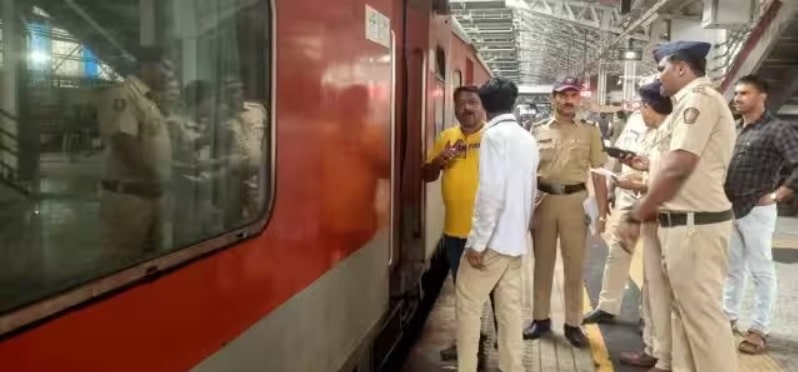What’s in today’s article?
- Why in news?
- What is Railway Protection Force (RPF)?
- How was the RPF created, and with what reasons?
- What is Government Railway Police (GRP)?
- What are the Challenges in the current system?
Why in news?
- A constable of the Railway Protection Force (RPF) allegedly shot and killed four people on board the Mumbai-bound 12956 Jaipur-Mumbai Superfast Express.
- Later, the accused was arrested by Government Railway Police (GRP).
What is Railway Protection Force (RPF)?
- About
- The RPF is an armed force under the operational and administrative control of the Union Ministry of Railways.
- It is tasked with protecting and securing railway property, the passenger areas, and the passengers themselves.
- Constitution
- The RPF was set up as a consequence of The Railway Protection Force Act, 1957.
- This act was enacted by Parliament to provide for the constitution and regulation of an armed force of the Union for the better protection and security of railway property.
- The Act came into force after Parliament passed significant modifications to it through The Railway Protection Force (Amendment) Act, 1985.
- The RPF was set up as a consequence of The Railway Protection Force Act, 1957.
- Function and area of operation
- The force is more than 74,000 strong, and distributed over the entire length and breadth of the country.
- Its area of operation is massive, and its responsibilities huge.
- India Railways carry approximately 22 million passengers and over 3 million metric tons of freight everyday over more than 63,000 kilometres of railway network.
- The Railway Protection Force guards this vital artery of the economy of the Nation
How was the RPF created, and with what reasons?
- Origin
- The RPF has its origins in the ‘Watch and Ward’ set-up of the private railway companies during the time of the British Raj.
- Later, a Committee under the Director of the Intelligence Bureau was set up in 1954, which recommended the reorganisation of the Watch and Ward into a statutory body.
- Reasons for creation
- Security problems of the Railway passengers, especially those relating to the security of his person and property during his rail journey, are really serious.
- The fear of terrorist activity in the form of blowing up of tracks and trains further aggravates this problem.
- Unscheduled stoppages and delays due to law and order problems such as demonstrations, dharnas en route, compound the miseries.
What is Government Railway Police (GRP)?
- About
- The GRP is a part of the district police force, reporting to the state government.
- It works alongside the RPF, and should, under ideal circumstances, complement and strengthen its operations.
- Functions
- The Government Railway Police are responsible generally for the prevention and detection of crime on railways.
- But their remit does not extend to protecting Railway property.
- The protection of goods sheds, goods wagons at stations and parcel offices is not duty of the Railway Police, but of the Railway Protection Force of the Railway.
- Its function is to:
- maintain order at railway stations and in trains;
- maintain order in passenger trains halted at stations;
- prevent overcrowding in carriages, “
- arrest of persons guilty of committing nuisance, etc.
- GRP can also be utilised for track patrolling and for effective investigation in cases of sabotage.
What are the Challenges in the current system?
- Division of responsibilities
- While the role of the RPF has diversified over the years, the primary role of maintaining law and order remained the liability of the State Government.
- Hence, the system as it developed, led to a division of responsibilities between the State Police and the RPF.
- No continuity of jurisdiction for GRP
- GRP is organised on provincial lines, there is no continuity of jurisdiction.
- For instance, for a distance of 70 kilometres involving travel time of about an hour, between Ambala to Kalka, four GRP units look after a passenger.
- A seamless line of control and a single chain of command is lacking because of the boundaries of States and therefore, of their Police Forces.
- GRP is organised on provincial lines, there is no continuity of jurisdiction.
- Confusion due to multiplicity of forces
- With a multiplicity of security agencies operating on the Railway i.e. the Railway Protection Force (RPF), the Government Railway Police (GRP) and the District Police, people get confused.
- They are not sure whom to report to in case of a crime on the railway.
- With a multiplicity of security agencies operating on the Railway i.e. the Railway Protection Force (RPF), the Government Railway Police (GRP) and the District Police, people get confused.
Q1) What was the function of Watch and Ward’?
Watch and Ward” was a term used in medieval England to describe a system of law enforcement that was established to maintain public order and security. The primary function of Watch and Ward was to protect towns and cities from various threats, such as criminals, burglars, and fires, during the night hours. This system was particularly important during a time when there were no professional police forces as we know them today.
Q2) What are the functions of Union Ministry of Railways?
The Union Ministry of Railways in India plays a vital role in overseeing and developing the vast Indian Railways network. This ministry is responsible for formulating policies related to railway operations, safety, infrastructure development, and modernization. Each year, the ministry prepares and presents the railway budget, allocating funds to various projects and maintenance activities. It focuses on planning and developing new rail lines, electrification, and dedicated freight corridors to enhance the country’s rail connectivity.
Source: RPF man held for killing 4 on train: What is this force, and how is it different from the GRP? | Indian Railway
Last updated on December, 2025
→ Check out the latest UPSC Syllabus 2026 here.
→ Join Vajiram & Ravi’s Interview Guidance Programme for expert help to crack your final UPSC stage.
→ UPSC Mains Result 2025 is now out.
→ UPSC Notification 2026 is scheduled to be released on January 14, 2026.
→ UPSC Calendar 2026 is released on 15th May, 2025.
→ The UPSC Vacancy 2025 were released 1129, out of which 979 were for UPSC CSE and remaining 150 are for UPSC IFoS.
→ UPSC Prelims 2026 will be conducted on 24th May, 2026 & UPSC Mains 2026 will be conducted on 21st August 2026.
→ The UPSC Selection Process is of 3 stages-Prelims, Mains and Interview.
→ UPSC Result 2024 is released with latest UPSC Marksheet 2024. Check Now!
→ UPSC Prelims Result 2025 is out now for the CSE held on 25 May 2025.
→ UPSC Toppers List 2024 is released now. Shakti Dubey is UPSC AIR 1 2024 Topper.
→ UPSC Prelims Question Paper 2025 and Unofficial Prelims Answer Key 2025 are available now.
→ UPSC Mains Question Paper 2025 is out for Essay, GS 1, 2, 3 & GS 4.
→ UPSC Mains Indian Language Question Paper 2025 is now out.
→ UPSC Mains Optional Question Paper 2025 is now out.
→ Also check Best IAS Coaching in Delhi

















